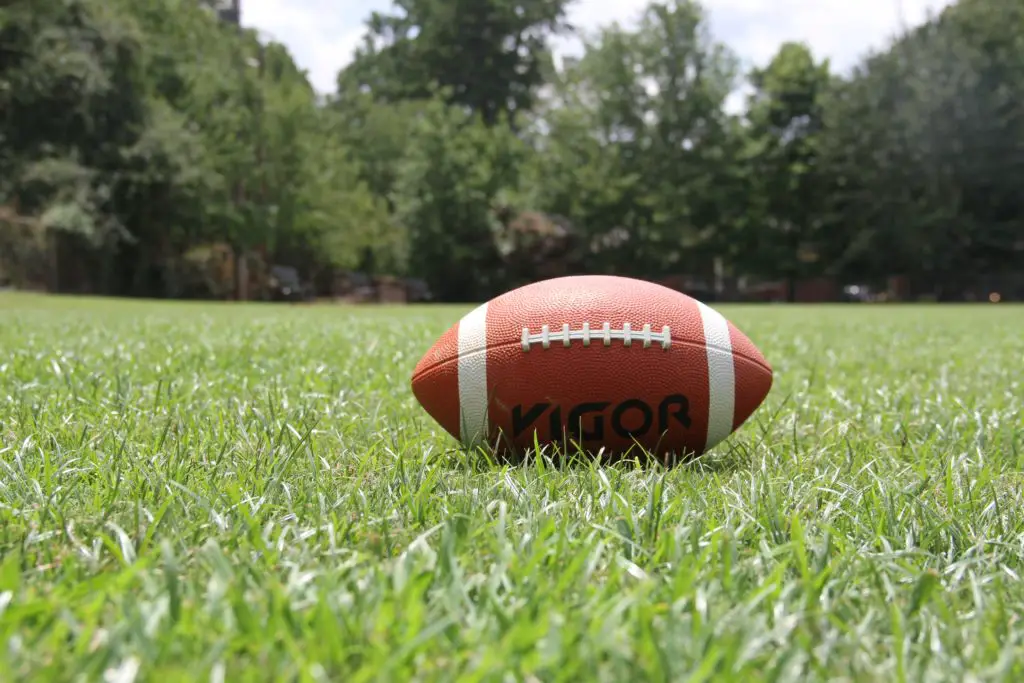It is not uncommon for a new NCAA college football enthusiast to wonder what painted white stripes on each end of the ball mean (and why the NFL did away with them) and the reason is just as obvious as one would expect. Let u discuss, Why is there a white stripe on a college football?

There are white stripes painted halfway through the circumference on each end of the college football to improve visibility when it is dark as well as to distinguish college-level NCAA football from pro football (NFL).
The Ball Used By College Football Leagues (NCAA)
Various football leagues use different kinds of balls but they all have one of the following shapes:
- A sphere: used in Association and Gaelic football
- An elongated (prolate) sphere with:
- Pointed edges (used in Gridiron football)
- Round edges (used in Rugby and Australian football)
In an attempt to make the forward pass more effective, Hugh “Shorty” Ray introduced the Gridiron ball in 1934 which is the type of ball used in college football. It is prominently pointed on both sides and is made up of panels of cowhide leather that are tanned to a natural brown color in order to provide proper grip in both wet and dry conditions.
Historically, during nighttime games, footballs that were completely white were used in an attempt to increase ball visibility but in this time and age, due to the advances in artificial lighting, completely white balls were deemed unnecessary.
The white paint of the footballs was reduced to just two white lines on each end of the tan-brown leather balls which ran halfway through the circumference.
Adaptations of the White Lines
Although the NCAA uses balls with white lines running through both sides, many football leagues have taken these lines and made them their own in an attempt to distinguish themselves.
Here Are Some Examples
- The white lines across the whole circumference of the ball are used by the CFL.
- A black ball with red curved lines instead of the stripes was used in the XFL of 2001.
- A ball with lime green stripes was used in the UFL.
- The Arena Football League used a ball with a tan-and-navy color scheme with curved lines instead of stripes in 2003.
- In 2005, the American Indoor Football League used a white, red, and blue ball. The balls were used by the successors of the AIFL and the UIFL.
- A standard brown ball with ‘x’ markings instead of the white stripes was used by The XFL of 2020.
The White Stripes and Why The NFL Ball Doesn’t Have Them
Why is there a white stripe on a college football? The reason behind this is that college football stuck to an older, more traditional version of the ball. Every single football was made with white stripes back in the 1940s, until 1941, when the NFL switched the ball color to white with black stripes.
After stadium lighting improved, there was no longer a necessity for white balls, and Wilson, the company that supplied most college football leagues with their balls made a prototype without stripes. The NFL then chose that style to distinguish itself from other leagues.
Do the White Stripes Aid The Players In-Game?
Some studies do suggest that the white stripes also enhance the visibility of the ball when in flight, ensuring a better catch. This is the reason why high school footballs have a full stripe on them.
College football, as we know, uses balls with two white lines running halfway through the circumference on both sides, although their only purpose was to enhance nighttime visibility, the strobing effect caused by these lines due to the spiraling of the ball during flight might allow the player on the receiving end to read the spin more precisely, giving them an easier catch.
The players of the NFL are professionals whose talents and skills are expected to be at their peak, and they should be able to receive a throw unaided by the stripes, which is why their ball has none.
Conclusion
The white stripes on college football, while useful, are also an important part of football history. The lines that were meant to aid visibility now distinguish NCAA college football from the other leagues.
FAQs
1) What is the size of a college football?
A college football has a circumference of around 28 inches at the center and 21 inches on the shorter side of the ball and is 10.5 to 11.5 inches in length.
2) How large is the average NCAA football player?
The average NCAA football player weighs 232 pounds and is 6’2’’ tall.
3) Are NFL footballs bigger than college footballs?
An NFL ball is only slightly larger than a college football (about 1” in circumference and ½” in length).
4) How long does a football last?
A standard NCAA college football will last, at best, for 6 months.